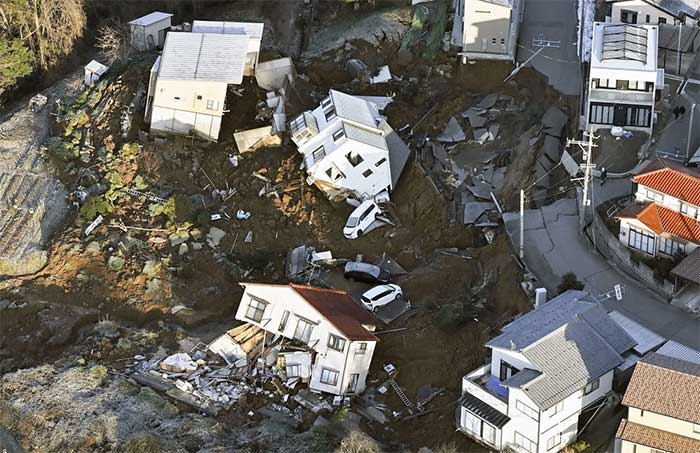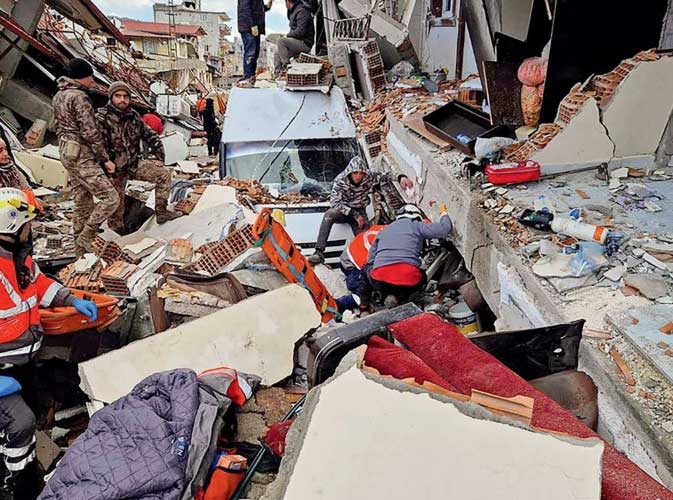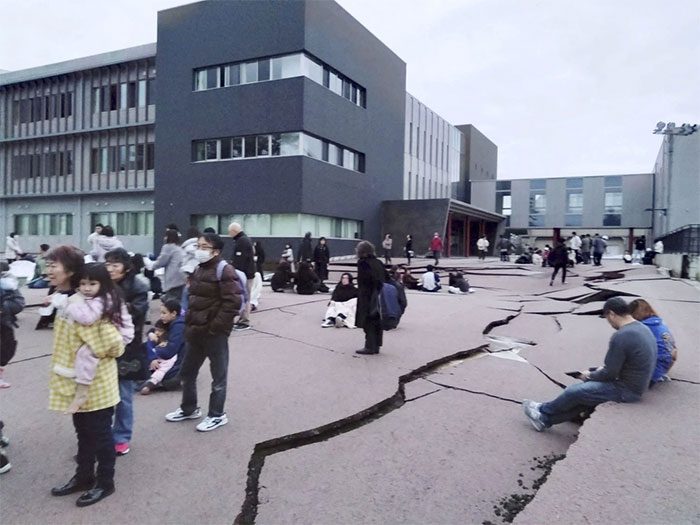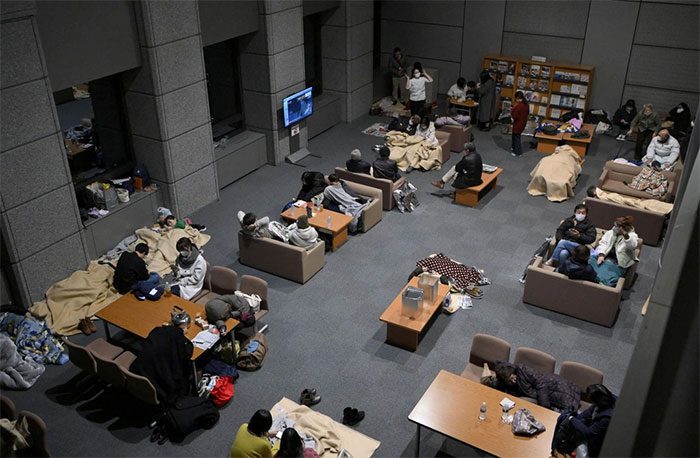On September 1, 1923, Japan experienced the most devastating earthquake in its history, measuring 7.9 on the Richter scale, which destroyed the capital and triggered a tsunami. Tokyo remains vigilant as it awaits the next “Big One.”
“Big One” is the term used by scientists to refer to a major earthquake that may occur cyclically.

On January 1, Japan experienced a 7.4 magnitude earthquake. (Photo: Reuters).
Recent deadly earthquakes in Japan, Morocco, and Turkey serve as a reminder that science must strive harder to predict these complex phenomena, even as measurement devices continue to improve.
On February 6, 2023, two earthquakes struck Turkey and Syria, resulting in over 50,000 deaths and the destruction of thousands of buildings.
Similarly, the catastrophic earthquake on September 1, 1923, in Japan left 2 million people homeless and resulted in 142,000 fatalities. A century later, Tokyo must remain alert as it anticipates the next “Big One.”
According to a study by the Japan Meteorological Agency, there is a 70% risk of a major earthquake occurring within the next 30 years. Concerns also exist in California, USA, particularly in the San Francisco area, where the last major earthquake occurred in 1906.
The United States Geological Survey (USGS) states that the frequency of such disasters is approximately once every 200 years. However, the USGS estimates that the probability of a magnitude 7 event occurring in the next 30 years is 67%.
The understanding of the origins of these phenomena dates back over half a century with the discovery of plate tectonics. This refers to the Earth’s outer shell—the lithosphere—composed of plates that move relative to one another.
In Japan and California, earthquakes occur frequently due to these regions being located at the boundaries of multiple tectonic plates.
Friction has prevented these plates from moving, causing them to become stuck until the accumulated energy leads to a rupture, often along a pre-existing fault line.

In February 2023, two earthquakes in Turkey and Syria resulted in over 50,000 deaths and the destruction of thousands of buildings. (Photo: REA).
The energy is then released in the form of seismic waves, also known as an earthquake.
Professor of Tectonics Richard Walker from the University of Oxford explains: “After an earthquake, most fault lines will close. Then, the stress will begin to build up until the next earthquake occurs, which is why we talk about a seismic cycle.“
New Earthquake Forecasting Technology
Historical data is essential for analyzing earthquake frequency and assessing seismic hazards.
In the past 30 years, satellite technology has revolutionized the seismic world. Thanks to GPS data and Interferometric Synthetic Aperture Radar (InSAR), scientists can monitor the movement of plates and the deformation of the crust around faults to the millimeter.
They have access to increasingly accurate data to assess the accumulated mechanical stress in a fault, which is a good indicator of seismic risk.
These technologies also allow them to detect an unexpected phenomenon, first observed in Japan in 1999, known as slow earthquakes.
Seismologist Harold Tobin from the University of Washington describes: “This is a type of movement similar to a regular earthquake, but it happens over days or weeks and does not produce any dangerous seismic waves.”
As a result, scientists are asking new questions: What controls friction on a fault? Why does it sometimes break or slip slowly?
To understand this mechanism, geologists delve into faults to collect rock samples and directly measure stress.
The results show that the majority of earthquakes occur at tectonic plate boundaries, where most stress is concentrated. The strongest earthquakes occur in the Pacific Ring of Fire, characterized by subduction zones.
Less commonly, earthquakes can also occur within plates, particularly in areas with undiscovered old faults.

A road in Wajima City, Ishikawa Prefecture cracked after an earthquake. (Photo: Reuters).
Harold Tobin adds: “Faults do not always show clear signs on the surface. However, thanks to Lidar, an aerial laser remote sensing method that allows for detailed topographic measurements of the Earth, new faults have been discovered.”
The seismologist expresses amazement: “With Lidar technology, we can see through vegetation and thus discover faults we did not know existed.”
This is how South Korean researchers discovered an unknown fault in the middle of a forest in 2022.
Additionally, seismologists evaluate the intensity of past events to more accurately determine high-risk areas.
While the Richter scale remains familiar to the public, it has not been used in the scientific community since 1970, giving way to the concept of magnitude, a universal measure of the amount of energy released.
Harold Tobin explains: “Intensity is measured on a logarithmic scale. An earthquake with a magnitude of 8 will produce seismic waves that are 10 times stronger than a magnitude 7 earthquake and release over 30 times more energy.”
A magnitude 6 earthquake can cause severe damage to buildings. At a magnitude of 8, the released energy is over 900 times greater.
However, this measurement alone is insufficient to predict the destructive nature of an earthquake, and scientists need to supplement with local geology, the distance from the epicenter, and the depth of the focus where the tremors occur.
This data helps determine the earthquake’s intensity. The closer one is to the earthquake’s source, the stronger and more dangerous the tremors will be.
Richard Walker emphasizes: “Seismic waves have the most devastating impact at high frequencies, but they dissipate quickly depending on the transmission distance. In the case of a deeper earthquake, a significant amount of energy will be diminished before reaching the epicenter.”
For example, the epicenter of the earthquake that occurred in Morocco in September 2023 was at a depth of 18 km—considered very shallow—and the epicenter was located 71 km from Marrakech, one of the most populous cities in Morocco.

According to Kyodo News, nearly 100,000 people in central Japan were ordered to evacuate after a series of earthquakes in the area. In the photo: Residents evacuated to the government building in Kanazawa, Ishikawa Prefecture. (Photo: Reuters).
As a result, the intensity of the earthquake there was quite strong, which is why it caused such severe damage.
Aftershocks Can Also Be Devastating
Furthermore, an earthquake can become even more catastrophic when accompanied by aftershocks, which are secondary tremors.
These occur when the tremors from the earthquake transfer stress to adjacent sections of the fault, causing other earthquakes.
This is what happened in Turkey and Syria in February 2023. A strong aftershock measuring 7.5 occurred just minutes after the main earthquake, which measured 7.8.
Accelerating Early Tsunami Detection
Earthquakes in coastal countries often trigger a series of waves that can exceed 30 meters in height. This is one of the most destructive natural disasters.
According to a study published by American geologists in 2022, tsunami waves originating from seismic activity account for 80%. However, they can also be triggered by underwater landslides or volcanic eruptions.
Tsunamis primarily occur in subduction zones, located in shallow waters. Since the tsunami in the Indian Ocean in 2004 (230,000 deaths) and the one in Japan in 2011 (22,000 deaths), the scientific community has mobilized research to mitigate the impacts of these disasters.
Early disaster detection strategies have developed in recent years, particularly thanks to advancements in data processing.
For instance, Japan has installed a widespread network of pressure sensors on the seabed off its coast.
Digital models analyze this data in real-time and can quickly detect the risk of a tsunami occurring, providing valuable information that allows communities time to evacuate.
- How is Japan preparing to deal with earthquakes?
- Earthquake in Japan causes ground to rise over 4 meters
- Disasters pile up in Japan: Earthquake causes major fires in buildings, widespread communication disruptions
- Strange phenomena before the earthquake in Japan: Unusual lights across the sky and flocks of birds creating a rare sight


















































